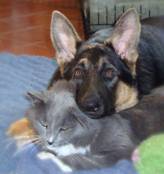How Commercial Pet Food is CookedCooked, commercial pet food has been popular since the 1940's and provides pet owners with incredible convenience. Just open a bag or can and voila' your pet's dinner is ready. Those cute kibble shapes and colors are sure to make meals more interesting for pets. The pictures of vibrant healthy animals in ads, prime cuts of raw meat and vegetables on the packaging prove it must be healthy food. Or is it? The traditional process of making commercial pet food (dry and canned) usually begins at a rendering plant. There is a lot of information on the internet about what goes on rendering plants. That is not what this article is about. Rendering must be mentioned, however because this is the first time most pet food ingredients are cooked. Dictionary.com's definition of rendering as it pertains to pet food is this - "to melt down; extract the impurities from by melting: to render fat". Also, "to process as for industrial use: to render livestock carcasses". Render Magazine's definition of rendering is: "The rendering industry processes or recycles animal by-products such as animal fat, bone, hide, offal, feathers, and blood into beneficial commodities including tallow, grease, and protein meals". When rendering is completed, the final products are then sent to their respective locations - labeled inedible. The rest of the cooking process goes something like this. According to the Pet Food Institute, once at the pet food manufacturing facility dry ingredients are mixed with moist ingredients to form a dough, then ‘pre-heated' (the second application of heat). This pre-conditions the dough to pass through the extruder. The extruder is essentially a large meat grinder. As the dough passes through the extruder, it is cooked at intensely high heat (the third heating). Pressure pushes the dough out the other end of the extruder where it is cut into kibble pieces. Then, the dough is dried... in an oven (the fourth heating). Canned food is a bit different to manufacture. The cannery receives the cooked protein meal, meat and/or fat product from the rendering facility - again, labeled inedible. Ingredients are then mixed together. Cans, pouches or trays are filled with the moist mixture, sealed and the food is cooked inside its container. Most canned food is heated only twice. The process (rendering, cooking, drying, baking and canning) alters and destroys essential vitamins, amino acids and enzymes that your pet needs. Nutritionally, the final product is quite far from its original raw beginning - if in fact, it did come from fresh cuts of meat, whole grains and fresh vegetables. In an attempt to compensate for the loss of nutrients, pet food manufacturers add synthetic vitamins and minerals back in to your pet's food. These you will see at the end of every cooked product's ingredient label. It has been proven with human diets that less heat processing yields more valuable, useable nutrients. While there are several pet food manufacturers who produce high quality kibble (starting with the finest ingredients and using a slow cooking/low heat process to minimize the nutrient loss), there are other alternatives to commercially prepared pet foods. For example:
Against The Grain Pet Nutrition is a company that does things differently. We are a small business that is excited about offering pet owners better choices in pet nutrition. We believe that choosing appropriate pet food (be it commercial, raw or home prepared) is the most important factor in any pet's preventative health, convalescence and longevity. Our name - Against The Grain - reflects our strong passion to provide pet owners with the knowledge to make healthy decisions about pet care even if we go ‘against the grain' of popular thinking. 
 To contact us:
To contact us:www.ATGPetNutrition.com 1024 County Road 109 Montevallo, AL 35115 Phone: 205-665-9026 Fax: 205-665-5683 [email protected] Copyright © 2024 Against The Grain Pet Nutrition, LLC.
|



